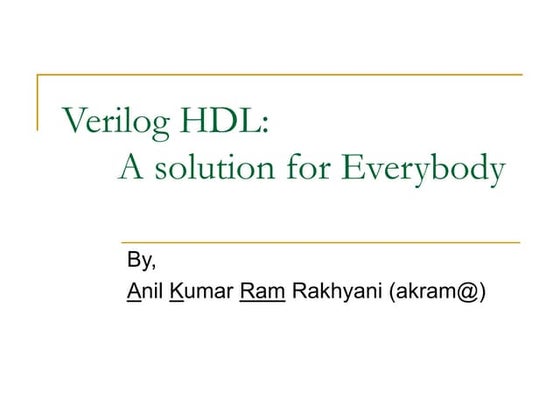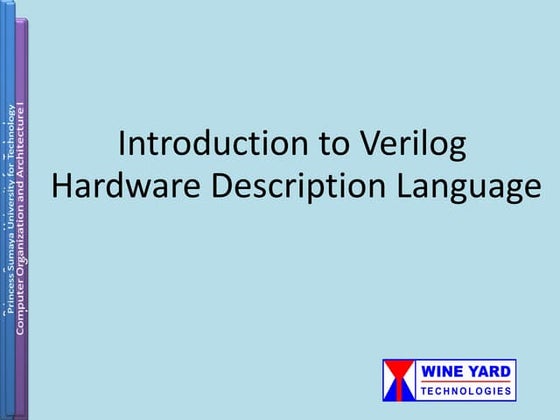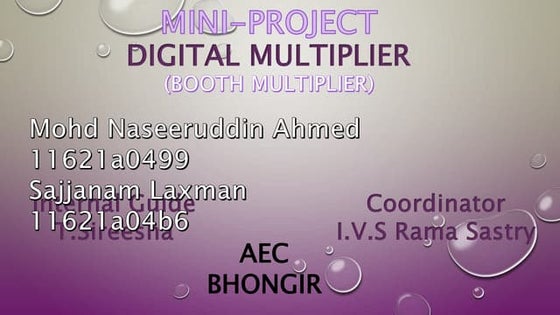Eecs 317 20010209
- 1. EECS 317 Computer Design LECTURE 4: The VHDL N-bit Adder Instructor: Francis G. Wolff wolff@eecs.cwru.edu Case Western Reserve University
- 2. Review: N-Bit Ripple-Carry Adder
- 3. Hierarchical design: 2-bit adder LIBRARY IEEE; USE IEEE.std_logic_1164.ALL; ENTITY adder_bits_2 IS PORT (Cin: IN std_logic; a0, b0, a1, b1: IN std_logic; S0, S1: OUT std_logic; Cout: OUT std_logic ); END; LIBRARY IEEE; USE IEEE.std_logic_1164.ALL; ENTITY adder_bits_2 IS PORT (Cin: IN std_logic; a0, b0, a1, b1: IN std_logic; S0, S1: OUT std_logic; Cout: OUT std_logic ); END; ? The design interface to a two bit adder is ? Note: that the ports are positional dependant (Cin, a0, b0, a1, b1, S0, S1, Cout)
- 4. Hierarchical design: Component Instance ARCHITECTURE ripple_2_arch OF adder_bits_2 IS COMPONENT full_adder PORT (x, y, z: IN std_logic; Sum, Carry: OUT std_logic); END COMPONENT; SIGNAL t1: std_logic; BEGIN FA1: full_adder PORT MAP (Cin, a0, b0, S0, t1); FA2: full_adder PORT MAP (t1, a1, b1, s1, Cout); END; Component instance #1 called FA1Component instance #1 called FA1 Component instance #2 called FA2Component instance #2 called FA2 Component DeclarationComponent Declaration
- 5. Positional versus Named Association FA1: full_adder PORT MAP (Cin, a0, b0, S0, t1); FA1: full_adder PORT MAP (Cin=>x, a0=>y, b0=>z, S0=>Sum, t1=>Carry); FA1: full_adder PORT MAP (Cin=>x, a0=>y, b0=>z, S0=>Sum, t1=>Carry); ? Positional Association (must match the port order) ? Named Association: signal => port_name FA1: full_adder PORT MAP (Cin=>x, a0=>y, b0=>z, t1=>Carry, S0=>Sum); FA1: full_adder PORT MAP (Cin=>x, a0=>y, b0=>z, t1=>Carry, S0=>Sum); FA1: full_adder PORT MAP (t1=>Carry, S0=>Sum, a0=>y, b0=>z, Cin=>x); FA1: full_adder PORT MAP (t1=>Carry, S0=>Sum, a0=>y, b0=>z, Cin=>x);
- 6. Component by Named Association ARCHITECTURE ripple_2_arch OF adder_bits_2 IS COMPONENT full_adder PORT (x, y, z: IN std_logic; Sum, Carry: OUT std_logic); END COMPONENT; SIGNAL t1: std_logic; -- Temporary carry signal BEGIN -- Named association FA1: full_adder PORT MAP (Cin=>x, a0=>y, b0=>z, S0=>Sum, t1=>Carry); -- Positional association FA2: full_adder PORT MAP (t1, a1, b1, s1, Cout); END; -- Comments start with a double dash-- Comments start with a double dash
- 7. Using vectors: std_logic_vector ENTITY adder_bits_2 IS PORT (Cin: IN std_logic; a0, b0, a1, b1: IN std_logic; S0, S1: OUT std_logic; Cout: OUT std_logic ); END; ENTITY adder_bits_2 IS PORT (Cin: IN std_logic; a0, b0, a1, b1: IN std_logic; S0, S1: OUT std_logic; Cout: OUT std_logic ); END; ? By using vectors, there is less typing of variables, a0, a1, ... ENTITY adder_bits_2 IS PORT (Cin: IN std_logic; a, b: IN std_logic_vector(1 downto 0); S: OUT std_logic_vector(1 downto 0); Cout: OUT std_logic ); END; ENTITY adder_bits_2 IS PORT (Cin: IN std_logic; a, b: IN std_logic_vector(1 downto 0); S: OUT std_logic_vector(1 downto 0); Cout: OUT std_logic ); END;
- 8. 2-bit Ripple adder using std_logic_vector ARCHITECTURE ripple_2_arch OF adder_bits_2 IS COMPONENT full_adder PORT (x, y, z: IN std_logic; Sum, Carry: OUT std_logic); END COMPONENT; SIGNAL t1: std_logic; -- Temporary carry signal BEGIN FA1: full_adder PORT MAP (Cin, a(0), b(0), S(0), t1); FA2: full_adder PORT MAP (t1, a(1), b(1), s(1), Cout); END; ? Note, the signal variable usage is now different: a0 becomes a(0)
- 9. 4-bit Ripple adder using std_logic_vector ARCHITECTURE ripple_4_arch OF adder_bits_4 IS COMPONENT full_adder PORT (x, y, z: IN std_logic; Sum, Carry: OUT std_logic); END COMPONENT; SIGNAL t: std_logic_vector(3 downto 1); BEGIN FA1: full_adder PORT MAP (Cin, a(0), b(0), S(0), t(1)); FA2: full_adder PORT MAP (t(1), a(1), b(1), S(1), t(2)); FA3: full_adder PORT MAP (t(2), a(2), b(2), S(2), t(3)); FA4: full_adder PORT MAP (t(3), a(3), b(3), S(3), Cout); END; ? std_vectors make it easier to replicate structures? std_vectors make it easier to replicate structures
- 10. For-Generate statement: first improvement ARCHITECTURE ripple_4_arch OF adder_bits_4 IS COMPONENT full_adder PORT (x, y, z: IN std_logic; Sum, Carry: OUT std_logic); END COMPONENT; SIGNAL t: std_logic_vector(3 downto 1); CONSTANT n: INTEGER := 4; BEGIN FA1: full_adder PORT MAP (Cin, a(0), b(0), S(0), t(1)); FA2: full_adder PORT MAP (t(1), a(1), b(1), S(1), t(2)); FA3: full_adder PORT MAP (t(2), a(2), b(2), S(2), t(3)); FA4: full_adder PORT MAP (t(n), a(n), b(n), S(n), Cout); END; Constants never change valueConstants never change value FA_f: for i in 1 to n-2 generate FA_i: full_adder PORT MAP (t(i), a(i), b(i), S(i), t(i+1)); end generate; LABEL: before the for is not optionalLABEL: before the for is not optional
- 11. For-Generate statement: second improvement ARCHITECTURE ripple_4_arch OF adder_bits_4 IS COMPONENT full_adder PORT (x, y, z: IN std_logic; Sum, Carry: OUT std_logic); END COMPONENT; SIGNAL t: std_logic_vector(4 downto 0); CONSTANT n: INTEGER := 4; BEGIN t(0) <= Cin; Cout <= t(n); FA_f: for i in 0 to n-1 generate FA_i: full_adder PORT MAP (t(i), a(i), b(i), S(i), t(i+1)); end generate; END; Keep track of vector sizesKeep track of vector sizes
- 12. N-bit adder using generic ? By using generics, the design can be generalized ENTITY adder_bits_4 IS PORT (Cin: IN std_logic; a, b: IN std_logic_vector(3 downto 0); S: OUT std_logic_vector(3 downto 0); Cout: OUT std_logic ); END; ENTITY adder_bits_4 IS PORT (Cin: IN std_logic; a, b: IN std_logic_vector(3 downto 0); S: OUT std_logic_vector(3 downto 0); Cout: OUT std_logic ); END; ENTITY adder_bits_n IS PORT (Cin: IN std_logic; a, b: IN std_logic_vector(n-1 downto 0); S: OUT std_logic_vector(n-1 downto 0); Cout: OUT std_logic ); END; ENTITY adder_bits_n IS PORT (Cin: IN std_logic; a, b: IN std_logic_vector(n-1 downto 0); S: OUT std_logic_vector(n-1 downto 0); Cout: OUT std_logic ); END; GENERIC(n: INTEGER := 2); Default case is 2Default case is 2 a, b:IN std_logic_vector(n-1 downto 0); S: OUT std_logic_vector(n-1 downto 0);
- 13. For-Generate statement: third improvement ARCHITECTURE ripple_n_arch OF adder_bits_n IS COMPONENT full_adder PORT (x, y, z: IN std_logic; Sum, Carry: OUT std_logic); END COMPONENT; SIGNAL t: std_logic_vector(n downto 0); BEGIN t(0) <= Cin; Cout <= t(n); FA: for i in 0 to n-1 generate FA_i: full_adder PORT MAP (t(i), a(i), b(i), S(i), t(i+1)); end generate; END;
- 14. Stimulus Only Test Bench Architecture ARCHITECTURE adder_bits_4_tb_arch OF adder_bits_4_tb IS COMPONENT adder_bits_n GENERIC(n: INTEGER := 2); PORT ( Cin: IN std_logic; a, b: IN std_logic_vector(n-1 downto 0); S: OUT std_logic_vector(n-1 downto 0); Cout: OUT std_logic END COMPONENT; SIGNAL x, y, Sum: std_logic_vector(n downto 0); SIGNAL c, Cout: std_logic; BEGIN x <= Ī░0000Ī▒, Ī░0001Ī▒ after 50 ns, Ī░0101Ī▒, after 100 ns; y <= Ī░0010Ī▒, Ī░0011Ī▒ after 50 ns, Ī░1010Ī▒, after 100 ns; c <= Ī«1Ī», Ī«0Ī» after 50 ns; UUT_ADDER_4: adder_bits_n GENERIC MAP(4) PORT MAP (c, x, y, Sum, Cout); END; MAP(4) Overrides default 2 MAP(4) Overrides default 2
- 15. Stimulus Only Test Bench Entity ENTITY adder_bits_4_tb IS PORT (Sum: std_logic_vector(3 downto 0); Cout: std_logic ); END; ENTITY adder_bits_4_tb IS PORT (Sum: std_logic_vector(3 downto 0); Cout: std_logic ); END; The output of the testbench will be observe by the digital waveform of the simulator.
- 16. Review: 1-bit Tri-State buffer oe yx ENTITY TriStateBuffer IS PORT(x: IN std_logic; y: OUT std_logic; oe: IN std_logic ); END; ENTITY TriStateBuffer IS PORT(x: IN std_logic; y: OUT std_logic; oe: IN std_logic ); END; ARCHITECTURE Buffer3 OF TriStateBuffer IS BEGIN WITH oe SELECT y <= x WHEN Ī«1Ī», -- Enabled Ī«ZĪ» WHEN OTHERS; -- Disabled END; OTHERS includes 0, W, X, L, H, U cases OTHERS includes 0, W, X, L, H, U cases
- 17. N-bit Tri-State Buffer entity ENTITY TriStateBufferN IS GENERIC( n: INTEGER := 8); PORT ( x: IN std_logic_vector(n-1 downto 0; y: OUT std_logic_vector(n-1 downto 0); oe: IN std_logic); ); END; ENTITY TriStateBufferN IS GENERIC( n: INTEGER := 8); PORT ( x: IN std_logic_vector(n-1 downto 0; y: OUT std_logic_vector(n-1 downto 0); oe: IN std_logic); ); END; y7 y6 y5 y4 y3 y2 y1 y0 OE x7 x6 x5 x4 x3 x2 x1 x0
- 18. N-bit Tri-State Buffer architecture ARCHITECTURE TriStateBufferN_ARCH OF TriStateBufferN IS COMPONENT TriStateBuffer PORT (x: IN std_logic; y: OUT std_logic, oe: IN std_logic); END COMPONENT; BEGIN TB: FOR i IN 0 TO n-1 GENERATE TB_i: TriStateBuffer PORT MAP (x(i), y(i), oe); END GENERATE; END; y7 y6 y5 y4 y3 y2 y1 y0 OE x7 x6 x5 x4 x3 x2 x1 x0
- 19. ROM: 4 byte Read Only Memory Y1 Y0 Y2 Y3 A0 A1 D7 D6 D5 D4 D3 D2 D1 D0 OE 4 byte by 8 bit ROM ARRAY ENTITY rom_4x8 IS PORT(A: IN std_logic_vector(1 downto 0); OE: IN std_logic; D: OUT std_logic_vector(7 downto 0)); END; ENTITY rom_4x8 IS PORT(A: IN std_logic_vector(1 downto 0); OE: IN std_logic; D: OUT std_logic_vector(7 downto 0)); END;
- 20. ROM: 4 byte Read Only Memory ARCHITECTURE rom_4x8_arch OF rom_4x8 IS COMPONENT TriStateBufferN GENERIC(n: INTEGER := 1); PORT ( x: IN std_logic_vector(n-1 downto 0; y: OUT std_logic_vector(n-1 downto 0); oe: IN std_logic); END COMPONENT; SIGNAL ROMout: std_logic_vector(7 downto 0); BEGIN BufferOut: TriStateBufferN GENERIC MAP(8) PORT MAP(ROMout, D, OE); WITH A SELECT ROMout <= Ī░01000001Ī▒ WHEN Ī░00Ī▒, Ī░11111011Ī▒ WHEN Ī░01Ī▒, Ī░00000110Ī▒ WHEN Ī░10Ī▒, Ī░00000000Ī▒ WHEN Ī░11Ī▒; END; ARCHITECTURE rom_4x8_arch OF rom_4x8 IS COMPONENT TriStateBufferN GENERIC(n: INTEGER := 1); PORT ( x: IN std_logic_vector(n-1 downto 0; y: OUT std_logic_vector(n-1 downto 0); oe: IN std_logic); END COMPONENT; SIGNAL ROMout: std_logic_vector(7 downto 0); BEGIN BufferOut: TriStateBufferN GENERIC MAP(8) PORT MAP(ROMout, D, OE); WITH A SELECT ROMout <= Ī░01000001Ī▒ WHEN Ī░00Ī▒, Ī░11111011Ī▒ WHEN Ī░01Ī▒, Ī░00000110Ī▒ WHEN Ī░10Ī▒, Ī░00000000Ī▒ WHEN Ī░11Ī▒; END;
- 21. Review: 2-to-1 & Datapath Multiplexor 0 1 a b S Y WITH s SELECT Y <= a WHEN Ī«0Ī», b WHEN OTHERS; WITH s SELECT Y <= a WHEN Ī«0Ī», b WHEN OTHERS; behavioral WITH s SELECT Y <= a WHEN Ī«0Ī», b WHEN OTHERS; WITH s SELECT Y <= a WHEN Ī«0Ī», b WHEN OTHERS; Datapath is n bits wideDatapath is n bits wide Where is the difference?Where is the difference? 0 1 a b S Y n n n
- 22. Generic 2-to-1 Datapath Multiplexor Entity 0 1 a b S Y n n nLIBRARY IEEE; USE IEEE.std_logic_1164.all; ENTITY Generic_Mux IS GENERIC (n: INTEGER); PORT (Y: OUT std_logic_vector(n-1 downto 0); a: IN std_logic_vector(n-1 downto 0); b: IN std_logic_vector(n-1 downto 0); S: IN std_logic_vector(0 downto 0) ); END ENTITY;
- 23. Generic 2-to-1 Datapath Multiplexor Architecture ARCHITECTURE Generic_Mux_arch OF Generic_Mux IS BEGIN WITH S SELECT Y <= a WHEN "1", b WHEN OTHERS; END ARCHITECTURE; Configurations are require for simulation Configurations are require for simulation CONFIGURATION Generic_Mux_cfg OF Generic_Mux IS FOR Generic_Mux_arch END FOR; END CONFIGURATION;
- 24. VHDL Component, Entity, and Architecture Entity Architecturei Other Concurrent Components Concurrent Boolean Equations Component Instance Component Declaration for-generate | if generate Concurrent With-Select-When When-Else
- 25. Summary of VHDL Components Component Declaration COMPONENT component_entity_name [ GENERIC ( { identifier: type [:= initial_value ]; } ) ] [ PORT ( { identifier: mode type; } ) ] END; [ Optional ] { repeat } Component Instance identifier : component_entity_name [ GENERIC MAP ( identifier { ,identifier } ) ] [ PORT MAP ( identifier { ,identifier } ) ] ; mode := IN | OUT | INOUT type := std_logic | std_logic_vector(n downto 0) | bit Add ; only if another identifierAdd ; only if another identifier
- 26. Assignment #4 a) Write an N-bit ALU (default N=8) using the vhdl code of assignment #3 and then run (N=8) using vhdlan and vhdlsim assigns. The initial carry-in is set to zero and the final carry out is not needed. The N-bit ALU should only have x(n), y(n), s(n) and f. For multiple bits (i.e. std_logic_vector) use: assign Ī░00101111Ī▒ Y #binary or assign XĪ▒2fĪ▒ Y #hex notation Write a one useful test case for each function. Make sure it gives the correct results (i.e. please debug your ALU)! Hand in the source files and session using the Unix script command. b) Write an 8-bit ALU test bench in VHDL and hand in the source files and session using the Unix script command.

























![Summary of VHDL Components
Component Declaration
COMPONENT component_entity_name
[ GENERIC ( { identifier: type [:= initial_value ]; } ) ]
[ PORT ( { identifier: mode type; } ) ]
END;
[ Optional ] { repeat }
Component Instance
identifier : component_entity_name
[ GENERIC MAP ( identifier { ,identifier } ) ]
[ PORT MAP ( identifier { ,identifier } ) ]
;
mode := IN | OUT | INOUT
type := std_logic | std_logic_vector(n downto 0) | bit
Add ; only if another identifierAdd ; only if another identifier](https://image.slidesharecdn.com/eecs31720010209-130524224412-phpapp02/85/Eecs-317-20010209-25-320.jpg)
















































